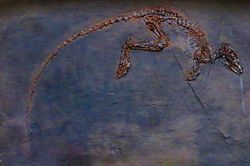Leptictidium auderiense
|
Leptictidium Temporal range: Middle Eocene, 50–35 Ma |
|
|---|---|
 |
|
| Fossil L. auderiense skeleton, Muséum national d'histoire naturelle | |
| Scientific classification | |
| Kingdom: | Animalia |
| Phylum: | Chordata |
| Class: | Mammalia |
| Order: | †Leptictida |
| Family: | †Pseudorhyncocyonidae |
| Genus: | †Leptictidium |
| Type species | |
|
†Leptictidium auderiense Tobien, 1962 |
|
| Species | |
|
|
Leptictidium (meaning "graceful weasel" in Latin) is an extinct genus of small mammals; together with macropods, giant pangolins, and humans, they are the only known completely bipedal mammals. Comprising eight species, they resembled today's elephant shrews. They are especially interesting for their combination of characteristics typical of primitive eutherians with highly specialized adaptations, such as powerful hind legs and a long tail which aided in locomotion. They were omnivorous, their diet a combination of insects, lizards and small mammals. One of the first branches to split from basal eutherians, they appeared in the Lower Eocene, a time of warm temperatures and high humidity, roughly fifty million years ago. Although they were widespread throughout Europe, they became extinct around thirty-five million years ago with no descendants, probably because they were adapted to live in forest ecosystems and were unable to adapt to the open plains of the Oligocene.
Leptictidium is a special animal because of the way its anatomy combines quite primitive elements with elements which prove a high degree of specialization. It had small fore legs and large hind legs, especially at the distal side (that further from the body). The lateral phalanges of its forelegs (fingers I and V) were very short and weak, finger III was longer and fingers II and IV were roughly equal in size, and slightly shorter than finger III. The tips of the phalanges were elongated and tapered.
The ankles and the sacroiliac joint were quite loosely fixed, while the pelvis had a flexible joint with only one coccygeal vertebra. The anteorbital muscle fenestrae in their crania suggest they probably had a long and mobile snout, similar to that of elephant shrews.
...
Wikipedia
